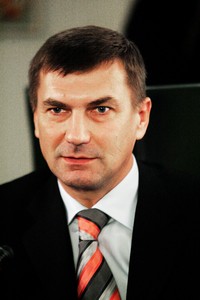
BRONZE SOLDIER SET TO LEAVE TALLINN AS LAST SOVIET SOLDIER
Publication: Eurasia Daily Monitor Volume: 4 Issue: 9
By:

On Wednesday, January 10, the Estonian parliament adopted in the third and final reading a “Law on the Protection of War Burial Sites,” clearing the way for the long-awaited removal of the monument to the Liberating Soviet Soldier from downtown Tallinn and other obtrusive symbols of the Soviet occupation in public places. President Toomas Ilves signed the law on the following day.
Under the law, such burial sites and the corresponding monuments or markings are subject to relocation if they are situated in inappropriate public places. Decisions on the matter shall be taken by the defense minister upon the advice of a Commission on War Burial Sites, which is being instituted by this law. The Estonian authorities have all along proposed transferring the monument to a memorial site on the city’s outskirts.
The public and parliamentary debate has focused on the towering bronze statue of the Soviet soldier, located on a mound at a busy traffic intersection in central Tallinn. Some claim that Soviet soldiers are buried underneath and that therefore the monument constitutes not only a political symbol, but also a war-graves memorial that may not be relocated. However, there is no evidence from the occupation era or from recent years to support this claim. The Estonian authorities intend — as Prime Minister Andrus Ansip confirmed on January 11 — to verify that claim by excavating the grounds and, if such remains are found, to re-bury them with full dignity in an appropriate war-graves site.
The parliament is currently considering two further draft laws on related issues. One bill would rename September 22 — the date of Tallinn’s capture by Soviet forces in 1944, marked as “Tallinn Liberation Day” during the occupation era — as a day of mourning. The other draft law would penalize the public display of Nazi and Soviet symbols in Estonia.
The parliament adopted the law on war memorials with 66 voting in favor, five opposed, and 30 absent or abstaining. This breakdown is identical to the parliament’s voting behavior during the presidential election in September. On that occasion, the Center Party led by Edgar Savisaar and allied deputies declined to vote in order to torpedo a parliamentary quorum. In the January 10 vote, the same deputies took an evasive position with an eye to the upcoming parliamentary elections. Center Party leaders count on local Russian votes and have signed a cooperation agreement with Russia’s party of power, United Russia.
Official Moscow is reacting vehemently to the Estonian parliament’s vote. Duma chair Boris Gryzlov and Federation Council chair Sergei Mironov, the two chambers’ international affairs committee’s chairmen, Konstantin Kosachev and Mikhail Margelov, the presidential administration’s Special Representative for Human Rights Vladimir Lukin, and other Russian officials seem inspired in their comments by three convergent approaches.
The first approach simply rehashes 50-year old Soviet themes: To dispute the Soviet “liberation” is tantamount to seeking “revision of the results of the Second World War,” to “lionizing fascism,” to offending the [war-time] “anti-Hitlerite coalition.”
The second theme rehashes Moscow’s response to the Baltic and other liberation movements of the late 1980s to 1991. As was then the case, Russian officials construe the Estonian parliament’s January 10 vote as pitting “nationalist radicals” against the “Russian-speaking population.” They also express hope that “healthy forces” — in this case, Savisaar’s party and its allies — would ultimately restore balance in Estonian society.
The third theme in Moscow officials’ response reflects the post-1991 line: Soviet rule in the Baltic states was “our common history,” repudiating it would be sacrilegious and also constitutes evidence of “neo-Nazi moods.”
Some of these reactions can sometimes bear a personal stamp. For example, according to Margelov, the “removal of monuments to liberating Soviet soldiers is akin to the Inquisition’s destruction of texts and monuments from the classical antiquity.” Kremlin consultant Vyacheslav Nikonov (grandson of Soviet Foreign Minister Vyacheslav Molotov) calls for breaking diplomatic relations with Estonia if the latter proceeds with a “systematic removal of [Soviet] monuments.”
Kosachev, who also heads the bicameral Russian parliament’s delegation to the Parliamentary Assembly of the Council of Europe, vows to seek censure of Estonia at the PACE session later this month. Kosachev forcefully led a partially successful battle in 2005 to water down PACE’s resolution of condemnation of communism.
On this issue, however, such efforts stand little chance. PACE president Martin van der Linden, coincidentally in Moscow during and after the Estonian parliament’s vote, commented that the parliament took a sovereign decision, with which other parliaments or international organizations are not empowered to interfere.
(BNS, Interfax, January 10, 11)




